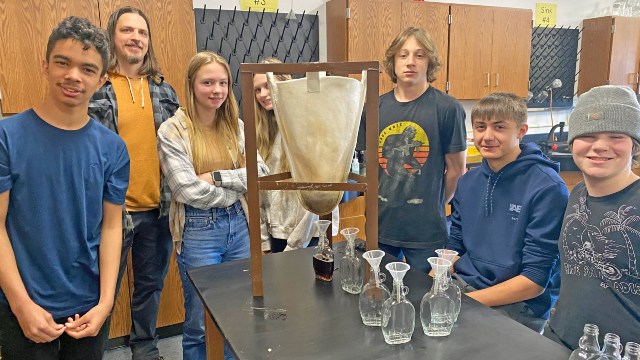By Carol Stiffler
Students in Newberry High School’s biology and physical science classes completed a very practical lesson plan this past spring: they tackled the science of maple syrup.
Hollis Yenna launched his first year of teaching the Tahquamenon Area Schools district by taking students outside to identify maple trees last fall – when they’re wearing the leaves that give away their identity. They found 19 maple trees on school property and noted them, and got permission from the Village of Newberry to tap 35 maple trees in Washington Park.
“We’d walk to Washington Park, and I’d say ‘Let’s play the maple game. There’s a maple. There’s a maple,’” said Yenna, who is in his sixth teaching position and taught most recently in Alaska. “They’re just all over the place.”
About 10 of his students had some experience with tapping maple trees and boiling down the sap into syrup, but it was new for the rest of them. And it got all of them outside.
“I like things that get kids outside,” Yenna said. “I’m very anti phone. I do whatever I can to encourage them to get out.”
Yenna dissected the six-week maple syrup lesson down to the nitty gritty parts.
“We try to cover every aspect we can: What’s in the sap; sap composition; all the trees that will do it. We break it down,” he said. “There is some math in it: Calculating how much syrup you hope to get out of the sap you have. We do all those equations, predict how much syrup we’re going to get.”
His students learned to tap trees – even double tapping some large trees – and haul sap back to school.
“From the biggest kid to smallest girls, I had them all hauling buckets,” Yenna said. They kept the sap outside in large rain barrels while it was cold. The class got firewood from a student’s father, who is a logger, and from another student’s grandfather. They boiled sap outside until it was nearly syrup, then finished it off on hot plates in the classroom.
“It’s a little makeshift, all of it,” Yenna said.
In all, the classes made two batches and more than nine gallons of syrup, which sold quickly within the building. One batch came out with classic maple flavor, and the other was smoky. The difference was in the kind of wood they were burning – hardwood for the classic flavor, and pine for the smoky. The classic version sold out promptly at $10 for 8 ounces. Those funds repaid Yenna for the supplies he’d purchased and profits were set aside for the science department.
Students celebrated the completed project with a pancake party. Yenna supplied the pancake ingredients and students brought in toppings – whipped cream, strawberries, chocolate chips.
The final verdict is complex, as you might expect.
“They’re all across the board,” Yenna said. “Some hate maple syrup. Some say ‘This is so cool; I wish I could do it.’ Several kids I sent taps home with. Go do it! Go make your own syrup! Some kids are really into it, and they really want to help.”
A lot of local people helped behind the scenes. “I was really impressed with how people saw we were doing something, spoke up, and offered resources. I think that’s pretty cool,” Yenna said.
Fellow teacher Linus Parr, who teaches trades skills and art at NHS, said it is fantastic “any time any one of us can give a practical application assignment like the syrup to our kids, and they can see from start to finish how it came about.”
Yenna is bringing “science projects that are engaging to our students,” Parr said, and has shared ideas with Yenna about creating a nature conservation class at the school.
Yenna said he likes interacting with students and finding projects they’ll enjoy, and he’s very comfortable in a rural setting like Newberry.
“I have a history of teaching in rural schools. The last town we were in had 1000 people. We lived in a town of 350 people at one point,” he said. “That’s the draw for me.”











